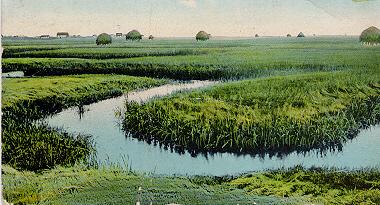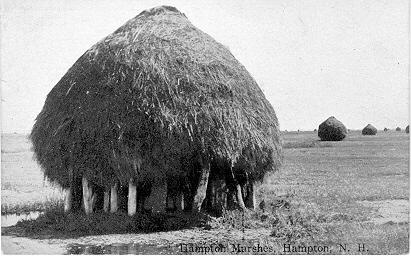By Ashlee Palmer & Nancy Devine
Atlantic News
March 9, 16 & 30, 2000
(Editor’s Note: The following articles are a series of four written and contributed by Winnacunnet High School Senior Seminar students Ashlee Palmer and Nancy Devine, with support from their Senior Seminar teachers, Hampton Conservation Commission members, and a UNH Cooperative Extension Project SERVE Coordinator.)
Restoring History
Part I

Sketch by Richard Montgomery — 1967
HAMPTON -— At first glance, the salt marshes in Hampton look like open fields of plants and grasses where many animals make their homes. However, many of them are in danger of being destroyed.
The 5000 acres of salt marsh between Hampton and Seabrook have been reduced in half since the Colonial days. The loss of these valuable salt marshes is directly associated with residential and industrial developments and with road construction.
Human uses of the salt marshes have changed over time. The recorded history of Hampton’s salt marshes dates back to the mid-1600s, when early settlers were attracted by the bountiful plant and animal life.
There were opportunities to use the marsh for many resources. The farmers would begin harvesting in August, and dig a hole a foot deep where they would cut salt meadow hay and later, leave it to dry for a couple of days on staddles. (The staddles were a framework of posts that stood higher than the marsh. The purpose of the staddles was to keep the hay dry when the tide came in.)
Over the course of time and into the 1930s, salt marshes were subjected to ditching and draining. Salt marshes were ditched in order to get a better quality of hay growth. The ditches helped to drain off the wettest places in order to make the haying process easier. Ditching also helped to keep the mosquitoes from breeding.
In addition, there was a negative side of ditching which caused fish to die that would have eaten the mosquito larvae. This ditching and draining led to the destruction of many marshes. Their degraded state remains today because of the pressures of development.
Salt marshes are very important to the community. They serve as a nursery for marine life when they are young. Also, the marshes are like sponges and they absorb water. The marsh allows the fish population to stay up, so that fishermen are able to still have jobs and make an income. Beyond all of the hidden benefits, salt marshes provide valuable open space along the Seacoast.
The Process Begins
Part II

[Post card courtesy Lane Memorial Library]
HAMPTON — When choosing what salt marsh to restore, many factors have to be considered. In Hampton, the Conservation Commission decided that the Meadow Pond and Charles Street salt marshes were in dire need of being restored because of how degraded they have become.
The first step for the Conservation Commission is to find out who owns the land around the salt marsh whether it is privately owned, or town- or state-owned land. When they find out who owns what, the commission starts making plans to restore the destruction that has already taken place.
The goal for restoring these salt marshes is to make each one become healthy living environments for animals, plants and people who live around them.
After the decision has been made on a site, the process of monitoring the salinity in the salt marsh begins. This process starts a year before any digging will happen and helps the restoring team keep track of the salinity level in the marsh. The salinity level becomes low when freshwater invades the marsh and becomes the dominant water source (if the salt marsh and foreign plants start to grow. This problem is the main focus for both salt marshes in Hampton.
Meadow Pond, which is located between High Street and Winnacunnet Road, became infested with phragmites. Phragmites are invasive plants that crowd native species and become dominant plants in the marsh. This plant is seen throughout degraded marshes because of its height, golden color and bushy-like top. This is a notable sign of freshwater flowing into the salt marsh. In addition to the phragmites destroying the marsh, it’s also a fire hazard, which means all the houses near the plants are in some kind of danger.
So the restoration plan is to dig a ditch around the perimeter to divert the freshwater from the marsh surface and also put a ditch plug at the creeks interface where freshwater is flowing in. Also, the Conservation Commission is potting in pannes, which are pools of water where fish can grow and wading birds can sit and rest.
The Charles Street marsh, located between Church and Charles Streets and Ross Avenue, has also become so degraded that you can hardly tell it is a salt marsh. This salt marsh is also being infested by phragmites because of the flow of fresh water coming into the marsh from storm water runoff.
The restoration plan for this salt marsh is to dig a 14″x18″ deep ditch that travels along the gravel parking lot near the marsh. The purpose of this ditch is to connect the salt marsh and the tidal creek allowing salt water to flow in at high tide. In addition to the digging, the Conservation Commission is also putting in three pannes to attract wildlife.
Many people might be wondering why the Conservation Commission is spending so much time with these salt marshes. The reason for the restoration plans are that healthy marshes help control the mosquito population, helps flood control and keeps fire hazard problems from getting dangerously high. Restoration supports marine life, and offers open space for beautiful landscapes. From these restoration plans, these two salt marshes can return to a state of healthiness instead of dying off.
Hampton Conservation Commission
Part III
Our past two articles gave a brief history of our salt marshes and the importance of maintaining healthy marshes. In this, our third article, we will walk you through the path to our goal, the restoration of our marshes.
After the specific area of restoration has been identified, the funding of the permit must begin.
Since the beginning of the salt marsh restoration project began here in Hampton, the Conservation Commission has been placing a $5000 article on the warrant to provide the matching dollars for the 50/50 grant which has been granted every year from the Office of State Planning Estuaries Program. Because the town has shown a commitment to the restoration of its marshes, other agencies such as US Fish and Wildlife, who provide the machinery that goes into the marsh for the restoration work. This has made it possible for the Conservation Commission to accomplish projects costing over three times the $15,000 that the tax payers contribute in the warrant article.
While all this funding is being addressed, applications are being prepared for the necessary permits needed to conduct the work in the marsh. The New Hampshire Department of Environmental Services (NHDES) has jurisdiction over all wetlands and 100 feet of tidal buffer in this state. The Commission therefore, must obtain a permit from the NHDES Wetland Bureau for the restoration work. In most instances, permits from the Army Corps of Engineers must also be applied for.
Only after all these permits are in hand and the funding is in place can the actual work of restoration begin.
How Salt Marshes Stay Healthy
Part IV

This, our final article, will deal with the actual work to be performed in order to increase the salinity in the marsh and stop the phragmites invasion.
In order to keep a salt marsh healthy, you need to have a source of salt water coming in without freshwater. There are several ways to prevent freshwater from coming into the marsh.
One way is to have a perimeter ditch around the marsh. These perimeter ditches do not allow fresh water to come in because they drain the fresh water out, which keeps the salinity high. These ditches run two feet wide by three feet deep. One of the goals for restoration work is to make sure that salt water is able to spread throughout the marsh. With these ditches the marsh will have a high enough salinity to support salt marsh plants and animals instead of fresh water plants and animals.
For the Landing Road Salt Marsh Project, which was done in 1997, the restoration team had to take out the old culvert, because it was falling apart and it was becoming very dangerous. The removal of the culvert left open a ditch that allowed more salt water to flow into the marsh. From this project, the salt marsh on Landing Road is slowly becoming healthier again.
With the great success that Landing Road salt marsh had, the Conservation Commission wants to do the same for Charles Street and Meadow Pond. Our salt marshes along the Seacoast need to stay in a healthy state. They provide a safe living environment for young marine life, reducing mosquito population, and are a valuable part of our town’s history.
(Editor’s Note: This concludes the four-article series by Ashlee Palmer and Nancy Devine. Illustrations added later and did not accompany the newspaper articles.)
See also Salt Marsh History By Ruth G. Stimson.